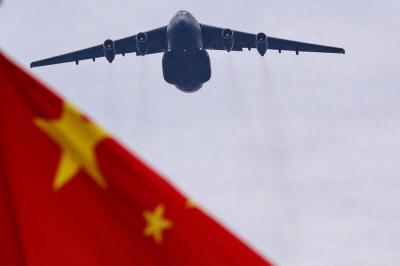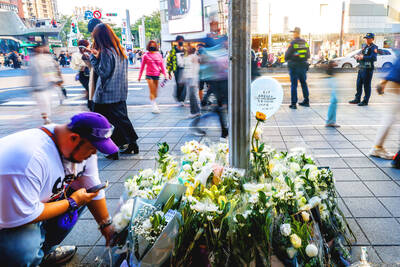There may be a new round of US arms sales to Taiwan next year, it was predicted on Friday at a Washington conference on cross-strait relations.
Experts refused to speculate on just what might be sold, but sources outside the conference said it was unlikely to include submarines or new advanced fighter planes.
Carnegie Endowment for International Peace vice president for studies Douglas Paal told the conference that “inevitably” there would be another round of arms sales to Taiwan toward the end of the administration of US President Barack Obama.
After first saying that US-China relations had experienced a “very rocky, scratchy” year, Paal said that Taiwan had military “needs” and that there was a broad consensus in the US to meet those needs.
The conference, organized by the Brookings Institution and the Association of Foreign Relations, was aimed at analyzing “key opportunities and challenges in cross-strait relations under new domestic, regional and global conditions.”
Paal, who once served as director of the American Institute in Taiwan (AIT) and was on the National Security staffs of former US presidents Ronald Reagan and George H.W. Bush, said that it was not known how Beijing would react to new arms sales.
“How the PRC [People’s Republic of China] will react, in great measure depends on the quality of the US-China relationship that prevails at the time,” he said.
He said that currently the US-China military-to-military relationship had reached a new high in terms of good contact and interaction.
“The PRC continues to develop its military capabilities and it does not make an exception opposite Taiwan,” Paal said.
He said that Taiwan had to face China’s military challenges and that it had its own need to upgrade its weapons.
Taiwan, could not match China’s military expansion, keep a balance or develop an offensive capability, he said.
However, he said it needed a “minimum necessary defensive capability.”
Paal said that the Obama administration had an obligation under the Taiwan Relations Act to consider Taiwan’s needs while at the same time it wanted to maintain relations with China.
Thus, the administration had to play a “very difficult game — more than a game,” he said.
“The administration has to meet the requirements under law to help Taiwan defend itself, and to do so in a way that doesn’t push us in the direction of unnecessary friction or conflict,” he said.
Paal said that in his opinion, next year was going to be a better year to conduct the arms sales than 2016, the year of the next US presidential election.
“But under what circumstances, and what materials will be transferred, will depend heavily on lower-level discussions on what the needs are,” he said.
Paal said that arms sales could be expected before the end of the Obama administration, but precisely when would depend on conditions.
Stimson Center East Asia program director Alan Romberg agreed with Paal’s prediction.
AIT Chairman Raymond Burghardt — who attended the conference, but was not one of the speakers — refused to comment on arms sales.
Pressed by members of the media to “say something” he said: “It’s a lovely day.”

Beijing could eventually see a full amphibious invasion of Taiwan as the only "prudent" way to bring about unification, the US Department of Defense said in a newly released annual report to Congress. The Pentagon's "Annual Report to Congress: Military and Security Developments Involving the People's Republic of China 2025," was in many ways similar to last year’s report but reorganized the analysis of the options China has to take over Taiwan. Generally, according to the report, Chinese leaders view the People's Liberation Army's (PLA) capabilities for a Taiwan campaign as improving, but they remain uncertain about its readiness to successfully seize

Taiwan is getting a day off on Christmas for the first time in 25 years. The change comes after opposition parties passed a law earlier this year to add or restore five public holidays, including Constitution Day, which falls on today, Dec. 25. The day marks the 1947 adoption of the constitution of the Republic of China, as the government in Taipei is formally known. Back then the Chinese Nationalist Party (KMT) governed China from Nanjing. When the KMT, now an opposition party in Taiwan, passed the legislation on holidays, it said that they would help “commemorate the history of national development.” That

Taiwan has overtaken South Korea this year in per capita income for the first time in 23 years, IMF data showed. Per capita income is a nation’s GDP divided by the total population, used to compare average wealth levels across countries. Taiwan also beat Japan this year on per capita income, after surpassing it for the first time last year, US magazine Newsweek reported yesterday. Across Asia, Taiwan ranked fourth for per capita income at US$37,827 this year due to sustained economic growth, the report said. In the top three spots were Singapore, Macau and Hong Kong, it said. South

HORROR STORIES: One victim recounted not realizing they had been stabbed and seeing people bleeding, while another recalled breaking down in tears after fleeing A man on Friday died after he tried to fight the knife-wielding suspect who went on a stabbing spree near two of Taipei’s busiest metro stations, Taipei Mayor Chiang Wan-an (蔣萬安) said. The 57-year-old man, identified by his family name, Yu (余), encountered the suspect at Exit M7 of Taipei Main Station and immediately tried to stop him, but was fatally wounded and later died, Chiang said, calling the incident “heartbreaking.” Yu’s family would receive at least NT$5 million (US$158,584) in compensation through the Taipei Rapid Transit Corp’s (TRTC) insurance coverage, he said after convening an emergency security response meeting yesterday morning. National